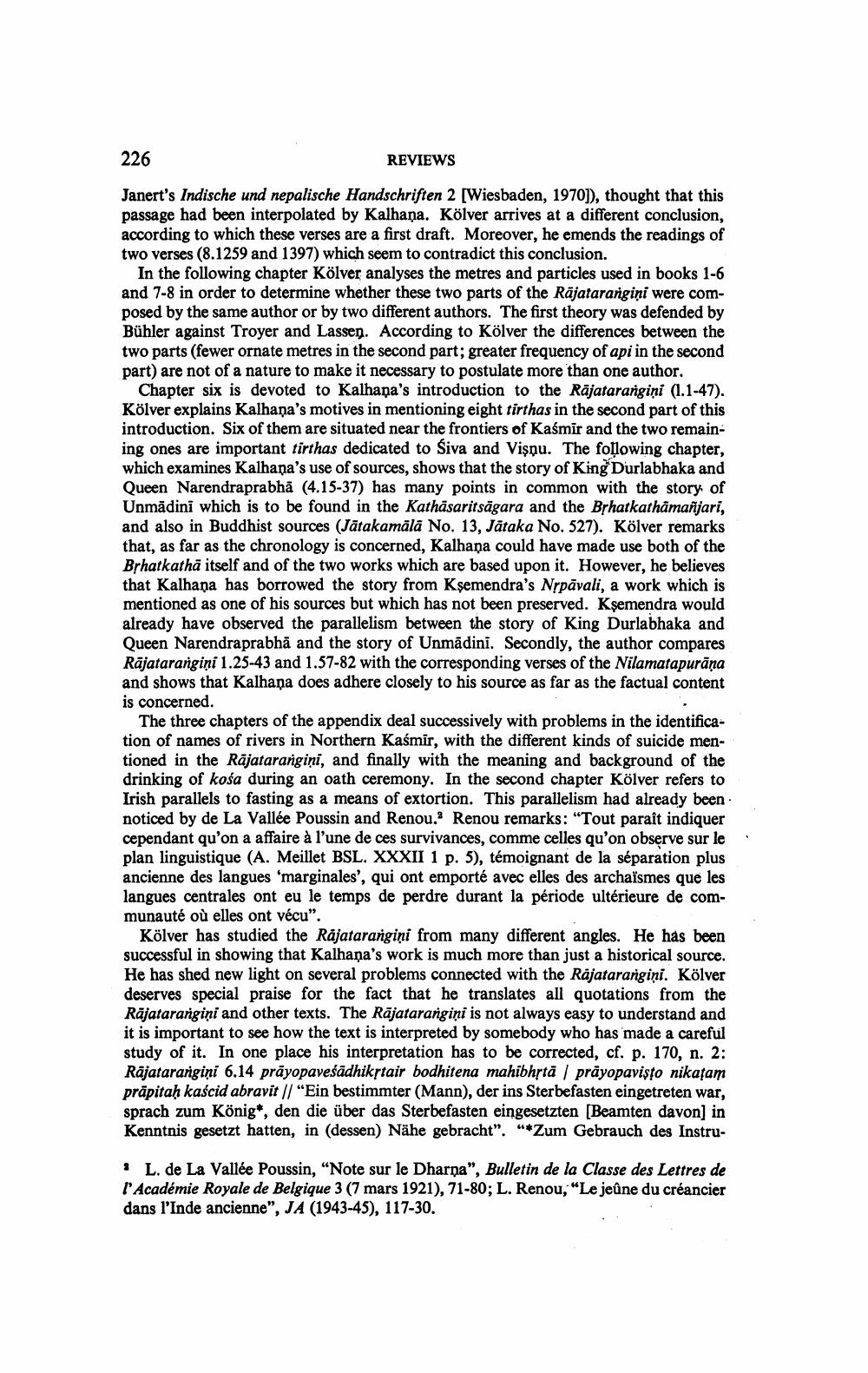________________ 226 REVIEWS Janert's Indische und nepalische Handschriften 2 [Wiesbaden, 1970]), thought that this passage had been interpolated by Kalhana. Kolver arrives at a different conclusion, according to which these verses are a first draft. Moreover, he emends the readings of two verses (8.1259 and 1397) which seem to contradict this conclusion. In the following chapter Kolver analyses the metres and particles used in books 1-6 and 7-8 in order to determine whether these two parts of the Rajatarangini were composed by the same author or by two different authors. The first theory was defended by Buhler against Troyer and Lassen. According to Kolver the differences between the two parts (fewer ornate metres in the second part; greater frequency of api in the second part) are not of a nature to make it necessary to postulate more than one author. Chapter six is devoted to Kalhana's introduction to the Rajatarangini (1.1-47). Kolver explains Kalhana's motives in mentioning eight tirthas in the second part of this introduction. Six of them are situated near the frontiers of Kasmir and the two remaining ones are important tirthas dedicated to Siva and Visnu. The following chapter, which examines Kalhana's use of sources, shows that the story of King Durlabhaka and Queen Narendraprabha (4.15-37) has many points in common with the story of Unmadini which is to be found in the Kathasaritsagara and the Brhatkathamanjari, and also in Buddhist sources (Jatakamala No. 13, Jataka No. 527). Kolver remarks that, as far as the chronology is concerned, Kalhana could have made use both of the Brhatkatha itself and of the two works which are based upon it. However, he believes that Kalhana has borrowed the story from Ksemendra's Nrpavali, a work which is mentioned as one of his sources but which has not been preserved. Ksemendra would already have observed the parallelism between the story of King Durlabhaka and Queen Narendraprabha and the story of Unmadini. Secondly, the author compares Rajatarangini 1.25-43 and 1.57-82 with the corresponding verses of the Nilamatapurana and shows that Kalhana does adhere closely to his source as far as the factual content is concerned. The three chapters of the appendix deal successively with problems in the identification of names of rivers in Northern Kasmir, with the different kinds of suicide mentioned in the Rajatarargini, and finally with the meaning and background of the drinking of kosa during an oath ceremony. In the second chapter Kolver refers to Irish parallels to fasting as a means of extortion. This parallelism had already been noticed by de La Vallee Poussin and Renou.Renou remarks: "Tout parait indiquer cependant qu'on a affaire a l'une de ces survivances, comme celles qu'on observe sur le plan linguistique (A. Meillet BSL. XXXII 1 p. 5), temoignant de la separation plus ancienne des langues 'marginales', qui ont emporte avec elles des archaismes que les langues centrales ont eu le temps de perdre durant la periode ulterieure de communaute ou elles ont vecu". Kolver has studied the Rajatarangini from many different angles. He has been successful in showing that Kalhana's work is much more than just a historical source. He has shed new light on several problems connected with the Rajatarangini. Kolver deserves special praise for the fact that he translates all quotations from the Rajatarangini and other texts. The Rajatarangini is not always easy to understand and it is important to see how the text is interpreted by somebody who has made a careful study of it. In one place his interpretation has to be corrected, cf. p. 170, n. 2: Rajatarargini 6.14 prayopavesadhikstair bodhitena mahibhsta / prayopavisto nikatam prapitah kascid abravit // "Ein bestimmter (Mann), der ins Sterbefasten eingetreten war, sprach zum Konig*, den die uber das Sterbefasten eingesetzten (Beamten davon) in Kenntnis gesetzt hatten, in (dessen) Nahe gebracht". "*Zum Gebrauch des Instru : L. de La Vallee Poussin, "Note sur le Dharna", Bulletin de la Classe des Lettres de l'Academie Royale de Belgique 3 (7 mars 1921), 71-80; L. Renou, "Le jeune du creancier dans l'Inde ancienne", JA (1943-45), 117-30.




